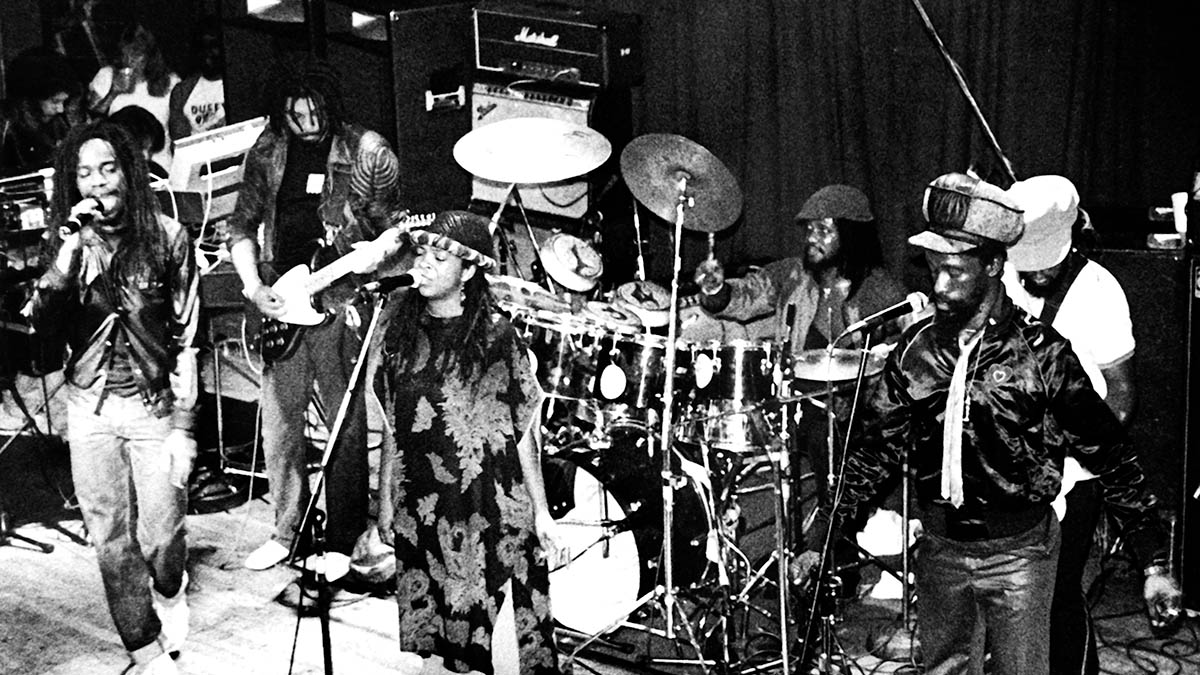How to play reggae guitar in the style of Black Uhuru
The six-string melodies of Grammy winners Black Uhuru typified a style of reggae known as ‘rockers’ – if you own a phaser pedal, now’s the time to use it

Black Uhuru has had numerous lineup changes over the years, but it was from 1979 through to 1986 where the band featured famed reggae producers Sly Dunbar and Robbie Shakespeare (Sly and Robbie).
As well as being a successful reggae production team, Sly and Robbie were also an in-demand rhythm section, playing drums and bass respectively.
A number of guitarists have held the six-string chair throughout Black Uhuru’s history, with probably the most well known being Mikey Chung, who played on the albums Anthem, Red and Chill Out. Black Uhuru’s current guitarist is Frank Stepanek, who made his first appearance with the band playing lead guitar on their 1986 album, Brutal.
Black Uhuru is associated with the ‘rockers’ style of reggae, which is slightly different to the one drop style associated with Bob Marley, and demonstrated in last month’s article.
Whereas one drop features a pattern where the kick drum is only played on beat three (often with a snare drum accent), the rockers style is more contemporary-sounding, with the kick played on beat one and the snare on beat three, as heard in countless rock and pop songs throughout the history of music.
The guitar ‘skank’ was usually simpler, too, with a basic off-beat strum played on beats two and four, and without any syncopated ghost notes (see last month’s column for various reggae rhythm permutations).
Black Uhuru have often featured dual-guitar lineups where the lead guitarist would play single-note lines, complementing the rhythm guitar, bass and keys. These melodic figures are very rhythmic and integral to the sound of the track, so are the main focus of this month’s pieces.
The band has tended to favour minor keys and, as a result, the minor pentatonic scale is often used by guitarists to play melodies, as heard in Black Uhuru songs such as Puff She Puff, Party Next Door and Sinsemilla.
The track Sinsemilla also features a phaser, a common effect used by reggae guitarists to give a swirling sound to their lines. The phaser pedal replicates a Leslie speaker and works by filtering the guitar’s frequencies to create a series of peaks and troughs in the waveform.
This type of effect was used by psychedelic guitarists such as Gilmour and Hendrix but was also adopted by reggae guitarists, as the space in the music allowed the sound to shine through.
This month’s examples and study piece focus on the kind of single-note lines used by Mikey Chung and Frank Stepanek. It’s important that you lock in with the rhythm section, maintaining a laid-back feel and emulating reggae’s relaxed nature. If you have access to a phaser effect, this is a great opportunity to explore its swirly, psychedelic textures in a reggae context.
Get the tone
Amp Settings: Gain 3, Bass 4, Middle 5, Treble 6, Reverb 4
Reggae ‘skank’ rhythms are usually played with a very clean tone, but no particular type of guitar or pickup is favoured. For melody playing, again the tone is clean but often sounds sweetest on the neck pickup.
If you have a phaser, experiment with the controls to find a sound that you like. Some light compression is useful too, as is some light reverb.
Examples
Example 1. Basic skank style: This first idea sets the scene for the following examples. Use downstrokes exclusively and aim for even dynamics and timing. A bit of compression if you have it, helps keep the volume and dynamic levels even.
Example 2. Palm muting single-note lines: Palm muting is used a lot in reggae music to keep the sound tight and to complement the bass. This example follows the chord progression using the A minor pentatonic scale almost exclusively, with the exception of the B note in the fourth bar, which is used to outline the G Major chord.
Example 3. Single-note lines using the minor pentatonic: This example shows how a simple idea can be used to great effect. It’s worth noting that there would be a vocal line over the top of these ideas, so it’s important that the guitar complement sthe melody but doesn’t get in the way. Ideas such as this are perfect for that very reason.
Example 4. Single-note lines using the minor pentatonic scale: This example follows on from the previous, showing how the minor pentatonic is often the perfect tool to complement the rest of the band without getting in the way. As with all of the examples, make sure you’re listening to the bass guitar, and of course the kick and snare drum.
Example 5. Single-note lines using 16th notes: This final example features a couple of 16nth notes to add some interest and a little more complexity to the lines. Note that the example starts on the ‘and’ of beat 1, as also seen in Example 3. We’ll see all of the ideas from the examples in the full study piece that follows. Now lay back and get in the reggae groove.
Study piece
[Bars 1-4] These bars introduce the chord progression for our study piece. We are using triads of Am and Dm, both in the 5th position. Make sure that you mute the bass strings and keep these small chords crisp and short.
[Bars 5-12] Here’s an A minor pentatonic, single-note idea in ‘call and response’ style. The first four bars mostly descend through the scale while the response in the following four bars ascends.
[Bars 13-20] Here we see another A minor pentatonic idea. This time most of the chords are targeted with the root, b7 (G note) and 5th (E note). The piece ends with a clipped A minor triad hit. Learn the whole piece then play through it several times to get used to locking into the reggae beat.
Get The Pick Newsletter
All the latest guitar news, interviews, lessons, reviews, deals and more, direct to your inbox!
Simon is a graduate of the UK's Academy of Contemporary Music and The Guitar Institute, and holds a Masters degree in music. He teaches, examines and plays everything from rock to jazz.
“There are so many sounds to be discovered when you get away from using a pick”: Jared James Nichols shows you how to add “snap, crackle and pop” to your playing with banjo rolls and string snaps
Don't let chord inversions bamboozle you. It's simply the case of shuffling the notes around








![Joe Bonamassa [left] wears a deep blue suit and polka-dotted shirt and plays his green refin Strat; the late Irish blues legend Rory Gallagher [right] screams and inflicts some punishment on his heavily worn number one Stratocaster.](https://cdn.mos.cms.futurecdn.net/cw28h7UBcTVfTLs7p7eiLe.jpg)


